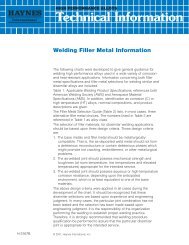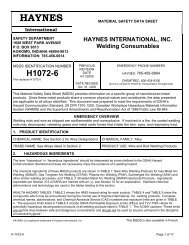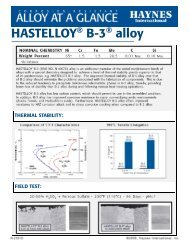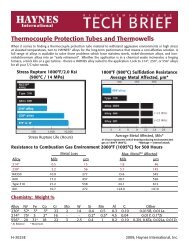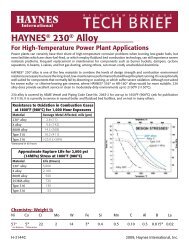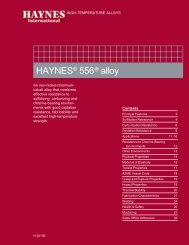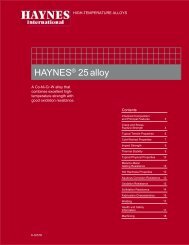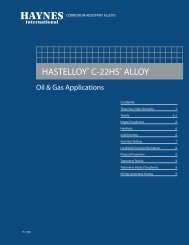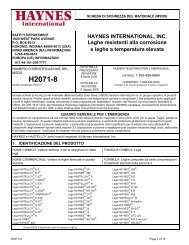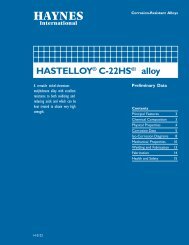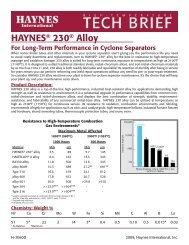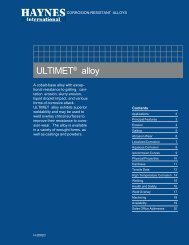HAYNES® HR-160® alloy - Haynes International, Inc.
HAYNES® HR-160® alloy - Haynes International, Inc.
HAYNES® HR-160® alloy - Haynes International, Inc.
You also want an ePaper? Increase the reach of your titles
YUMPU automatically turns print PDFs into web optimized ePapers that Google loves.
HEALTH AND SAFETY<br />
Those involved with the welding<br />
industry are obligated to provide<br />
safe working conditions and be<br />
aware of the potential hazards<br />
associated with welding fumes,<br />
gases, radiation, electrical<br />
shock, heat, eye injuries, burns,<br />
etc. Various local, municipal,<br />
state, and federal regulations<br />
(OSHA, for example) relative to<br />
the welding and cutting processes<br />
must be considered.<br />
Nickel-, cobalt-, and iron-based<br />
<strong>alloy</strong> products may contain, in<br />
varying concentrations, the<br />
following elemental constituents:<br />
aluminum, cobalt, chromium,<br />
copper, iron, manganese,<br />
molybdenum, nickel, and<br />
tungsten. For specific concentrations<br />
of these and other<br />
elements present, refer to the<br />
Material Safety Data Sheets<br />
(MSDS) H2071 and H1072 for<br />
the product.<br />
Acknowledgements<br />
20CB-3 is a trademark of Carpenter Technology Corporation.<br />
253 MA is a trademark of Avesta Jernverks Aktiebolag.<br />
800HT is a trademark of <strong>Inc</strong>o Family of Companies.<br />
RA85H, RA330 and RA333 are trademarks of Rolled Alloys, <strong>Inc</strong>.<br />
The operation and maintenance<br />
of welding and cutting equipment<br />
should conform to the<br />
provisions of American National<br />
Standard ANSI Z49.1, Safety in<br />
Welding and Cutting. Attention<br />
is especially called to Section 4<br />
(Protection of Personnel),<br />
Section 5 (Ventilation), and<br />
Section 7 (Confined Spaces) of<br />
that document. Adequate<br />
ventilation is required during all<br />
welding and cutting operations.<br />
Specific requirements are<br />
included in Section 5 for natural<br />
ventilation versus mechanical<br />
ventilation methods. When<br />
welding in confined spaces,<br />
ventilation shall also be sufficient<br />
to assure adequate<br />
oxygen for life support.<br />
The following precautionary<br />
warning, which is supplied with<br />
all welding products, should be<br />
provided to, and fully understood<br />
by, all employees involved<br />
with welding.<br />
HAYNES ® <strong>HR</strong>-160 ® <strong>alloy</strong> 22<br />
Caution<br />
Welding may produce fumes<br />
and gases hazardous to health.<br />
Avoid breathing these fumes<br />
and gases. Use adequate<br />
ventilation. See ANSI/AWS<br />
Z49.1, Safety in Welding and<br />
Cutting published by the American<br />
Welding Society.<br />
EXPOSURES: Maintain all<br />
exposures below the limits<br />
shown in the Material Safety<br />
Data Sheet, and the product<br />
label. Use industrial hygiene air<br />
monitoring to ensure compliance<br />
with the recommended<br />
exposure limits. ALWAYS USE<br />
EXHAUST VENTILATION .<br />
RESPIRATORY PROTECTION:<br />
Be sure to use a fume respirator<br />
or air supplied respirator when<br />
welding in confined spaces or<br />
where local exhaust or ventilation<br />
does not keep exposure<br />
below the PEL and TLV limits.<br />
WARNING: Protect yourself and<br />
others. Be sure the label is read<br />
and understood by the welder.<br />
FUMES and GASES can be<br />
dangerous to your health.<br />
Overexposure to fumes and<br />
gases can result in LUNG<br />
DAMAGE. ARC RAYS can<br />
injure eyes and burn skin.<br />
ELECTRIC SHOCK can kill.




